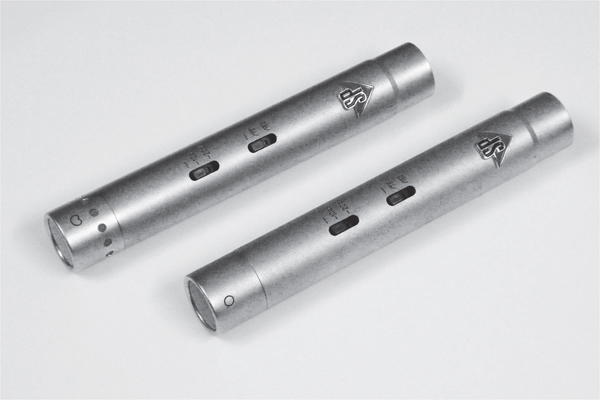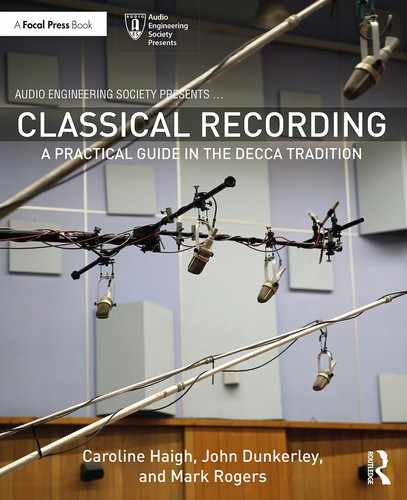Appendix 2
Cheaper alternatives to classic microphones
Throughout this book we have made reference to the microphone types used by Decca, especially those made by Neumann, Schoeps, Royer, AKG, and Coles. Many of these models, such as the Neumann M50 used for the Decca Tree, are no longer available, and on the rare occasions that such microphones come onto the second-hand market, they command extraordinarily high prices. Those models that are still available new are usually very expensive as well.
One of the key messages of this book is that is perfectly possible to make excellent recordings with cheaper alternatives. There’s no denying that a classic old Neumann in top condition costing £10,000 is a better-sounding microphone than a £100 mass-produced copy. But where the microphones are positioned and how they are balanced is at least as important as what the microphones are; a set of fabulous, expensive microphones put in the wrong places and badly balanced will make a worse recording than a set of reasonably good, cheap microphones positioned and balanced well.
A2.1 The importance of off-axis response when choosing alternative microphones
As we have shown, managing the quality of spill is a critical element in making a classical recording that works well. For example, for a successful violin and piano recording, the sound of the piano spill on the violin microphones needs to blend well with the sound of the piano on the piano microphones, and vice versa for the violin. Key to making this happen is the nature of the off-axis response of the microphones used. For spill to blend in well, the tone quality of sounds entering the side of a cardioid microphone should be as good as the tone quality of sounds entering at the front. This is not an easy thing for designers to achieve, and it is the reason why classic cardioid microphones such as the Neumann KM84 are so sought after – the off-axis sounds are of comparable tone quality to on-axis sounds, just lower in level. For some techniques, such as ORTF pairs, where most of the desired sound is entering the microphones off-axis, this is essential.
Almost all modern, cheaper condenser microphones sound good on-axis, but only some are good off-axis. Be sure to check the published polar plots of such microphones to see if they maintain a fairly consistent shape at different frequencies, and where they do vary, check that variation is smooth. If such information is unavailable, be more wary of making a purchase. Even better than relying solely on published data is to test them yourself. If you are able to borrow a pair and record a friendly musician with one microphone on-axis and the other off-axis, you will be able to compare the tone quality of the two signals in turn (after adjusting for level) and make a better assessment of the off-axis performance.
Note that budget omnidirectional microphones will usually be cheaper than budget cardioids as they are simpler to make. Producing a cardioid with a smooth off-axis response is more difficult.
A2.2 Acoustic pressure equalisers (spheres) for omnis
As shown in Chapter 8, the Decca Tree system works best with directional omnis, which can be made by mounting a pressure-operated microphone onto the surface of a sphere so that higher frequencies from off-axis are shielded by the sphere. Microphones such as the M50 were made this way, but it is possible to convert a cylindrical pencil microphone by adding a sphere – often called an acoustic pressure equaliser (APE). Branded APEs from the big manufacturers can be expensive, but for simple, cylindrical microphones without a tapered body, it is easy to make your own.
The microphone needs to be a single-diaphragm, pressure-operated omni (and not a variable directivity, dual-diaphragm design). For example, Figure A2.1 shows the excellent Studio Projects C4, which comes with both an omni and cardioid capsule. You can see that the cardioid capsule has holes around the capsule near the top, which allow some sound to access the rear of the diaphragm and gives the microphone its cardioid directional characteristic. But the omni capsule is sealed and responds as a simple pressure transducer to sounds approaching from all directions. This kind of microphone, with a ball attached, will be ideal for use in a Decca Tree.

Figure A2.1 Studio Projects C4s with omni and cardioid capsules
Photo: Mark Rogers.
The C4, along with the Behringer B5, has a cylindrical diameter of 20 mm. Figure A2.2 shows a home-made 48 mm diameter sphere with a 20 mm diameter bore. The solid plastic ball was purchased for about £6 from the Precision Plastic Balls Company (www.theppb.co.uk) and is made of Polyamide Nylon 66 Zytel. It was mounted tightly in a vice clamped to a bench drill, making sure that it was centred as accurately as possible under the drill bit, and very slowly drilled through using a high-quality 20 mm flat-blade wood bit. With a little bit of filing to remove any burred edges, the final result works perfectly.
The ball will slide comfortably over the cylinder of the microphone, but how do you ensure that it doesn’t fall off? Many of the commercially available spheres include one or more rubber O-rings mounted inside the bore, which provide a stable friction hold on the microphone body, but cutting the grooves where the O-rings will sit is a specialised task requiring a lathe, which is beyond the ability of many people. Fortunately, there’s an easy way out: just use Blu-Tak!

Figure A2.2 A home-made 48 mm microphone sphere
Photo: Mark Rogers.

Figure A2.3 Home-made sphere attached with Blu-Tak to Behringer B5 microphone
Photo: Mark Rogers.
Figure A2.3 shows our home-made sphere attached to a Behringer B5 microphone with Blu-Tak. The Blu-Tak makes an excellent adhesive bond to the nylon ball and the metal body of the microphone, and the whole unit feels very solid and stable.
One other task is necessary if using 48/50 mm spheres with the Studio Projects and Behringer microphones. These microphones have their attenuation switches positioned quite high up the body, and they are in the way of the ball when it is mounted flush with the capsule. Pushing the ball into place will force the attenuation switch to be engaged. A small notch needs to be filed at one end of the ball’s bore to accommodate the attenuation switch in either position.
The Behringer B5 is an extraordinary microphone for one in the budget range. It has a very even frequency response, low noise, and costs around £70 (2020 prices). So, for about £80, plus a few hours in a workshop, it is possible to make a Decca Tree–compatible microphone that compares quite favourably with classic microphones costing many thousands of pounds. There is no doubt that it is not as good as the real thing, but for those operating on a tight budget, realising maybe 90% of the performance for 3% of the cost is as good a deal as you are ever likely to get.
The Schoeps CMC series microphones (e.g. the MK2H or MK2S capsule attached to a CMC6 body) have a constant 20 mm diameter – which, by a fortunate coincidence, is exactly the same as the Studio Projects C4 and Behringer B5. So if you make a set of spheres for the cheaper microphones, they will still work if you are able to upgrade to the more expensive Schoeps microphones at a later date.
A2.3 High-frequency boost
A frequent criticism of modern cheaper microphones is that they are somewhat bright, with an exaggerated HF response. This can be a problem if they are used close to instruments, but for classical recording, where we are typically placing microphones much further away from the sound source, this can be a positive attribute. Many of the old classics, such as the Neumann M50, and more contemporary classics, such as the Schoeps MK2S, have intentional HF boosts to compensate for being used at a distance, where the air will have absorbed some of the HF (see Figure 8.10). This desired HF boost, combined with home-made APEs, make it possible to build a highly effective Decca Tree on a tight budget.
